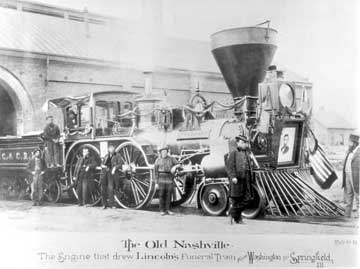Carrying Lincoln Home
by Jack Foran



Remembering the Great Emancipator's last trip through Buffalo
The feature image in an exhibit on Abraham Lincoln’s post-mortem last trip to Buffalo—this is the 150th anniversary year of Lincoln’s assassination—is a huge lithograph of the coffin and black-bunting-draped horse-drawn wagon that bore it along a parade route through downtown to St. James Hall, between Main and Washington streets, site of the present M&T Plaza, where the former president lay in state, open casket, for eight hours as an estimated 100,000 mourners filed by to pay their respects. The exhibit is in the lobby of the M&T office building at Main and Chippewa.
Also shown are the six white horses, blanketed and hooded in black, and attended by African-American Union Army soldiers no doubt—one attendant for each horse, it looks like—in mourning garb and Civil War soldier’s caps.
The parade with the coffin was actually the second Lincoln funeral procession in Buffalo. Several days previously—before it was announced that the funeral train carrying the body to Springfield would stop in Buffalo—a mock funeral parade was held here, composed of numerous military, civil, religious, and other groups. The same groups then assembled and marched again in the parade with actual coffin and corpse.
A pamphlet memorial of the occasion on display in the downtown library in an exhibit coincident with the M&T exhibit describes the parade. “The stores on Main street, and, indeed, throughout the greater portion of the city, were closed during the day. Many of the prominent places of business on Main street were elaborately and beautifully draped in white and black, and there was no place which did not exhibit some signs of mourning. Flags at half mast, shrouded and draped, were seen on every hand, and every possible mark of respect was apparent.”
The M&T display includes photos of the parade crowds and several display cases of Lincoln memorabilia—one of campaign buttons, one of remembrance buttons and other items, a bust statue of Lincoln, Lincoln book ends, etc.
The library display includes some Abraham Lincoln letters from the library collection. One from March 1864 to the newly elected governor of Louisiana—Louisiana had seceded from the Union, but parts, including New Orleans, were soon recaptured by federal troops, and the portion under federal control was considered a legitimate state within the Union—sheds light on Lincoln’s thoughts about enfranchisement of African-Americans as the necessary next step in the process he had begun with the Emancipation Proclamation of the previous year.
The letter says in part, “I barely suggest for your private consideration, whether some of the colored people may not be let in [that is, given the vote]—as, for instance, the very intelligent, and especially those who have fought gallantly in our ranks. They would probably help, in some trying times to come, to keep the service [or services?] of liberty within the family of freedom. But this is only a suggestion, not to the public, but to you alone.” Signed, “Yours truly, A. Lincoln.”

Both exhibits include the official list of marching groups in the funeral parade in marching order. About fifty groups in all, including various identifiably German ethnicity (Liedertafel, Turners, and Sängerbund) and Irish ethnicity (Friendly Sons of St. Patrick, Sons of Erin, Fenians) societies. And last in line: “Disabled soldiers in carriages, Citizens and strangers on foot and in carriages, [and] Colored citizens.”
The M&T display is a presentation of the Buffalo Presidential Center, which is a group of historians and history buffs and numerous collection items and a website “as [the center] works toward finding a brick and mortar home...” The website address is www.buffalopresidentialcenter.org.
Both displays will remain up through the end of June.
blog comments powered by Disqus|
Issue Navigation> Issue Index > v14n21 (Week of Thursday, May 28) > Carrying Lincoln Home This Week's Issue • Artvoice Daily • Artvoice TV • Events Calendar • Classifieds |









 Current Issue
Current Issue